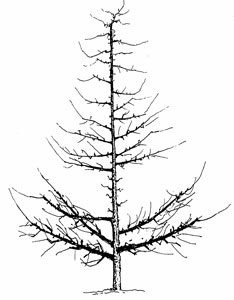To prune and train young apple trees successfully, you need to know something about the different growth habits of the varieties that you plant.
There are varieties where the bottom scaffolds can become very strong and dominant over the branches above them on the leader.
This is called basal dominance.
With basal dominant varieties it is easy to lose the leader. When this happens, the orchard cannot reach its full production potential. It is therefore most important that you keep the leader strong so that each tree can fill its space quickly with a balanced tree structure.
Varieties that tend to develop a strong base and a weak leader are: Fuji, Braeburn, Firmgold, spur-type Delicious and Cripps Pink (Pink Lady™ apples).
Some varieties like Granny Smith and Gala can do just the opposite.
These show strong growth of the leaders and can develop weak basal scaffolds. If the tops of the trees become vigorous, the trees develop canopies that resemble umbrellas. Such canopies cause excessive shading and subsequent loss of production.
Other varieties tend neither to be dominant in the base, nor to show strong growth of the leader. Golden Delicious, Smoothee, non-spurtype Delicious, Jonagold, Lady William and Cripps Red (Sundowner™ apples) have this growth habit.
These are only a few varieties, there are many others that fit these growth habits.
For the purpose of pruning and training your apple trees, the growth habits of most varieties fall into two categories. We express these categories as:
Strong Base—Weak Leader
or
Weak Base—Strong Leader
Special methods have been developed to deal with these contrasting growth habits.
More on growth habits
Each time you plant apple trees and are going to train them as Central Leader, you need to use several methods to get the right shape and balance in the trees that can quickly lead to sustained high production and fruit of good quality.
Blind wood
A growth habit that can limit the development of a balanced tree structure is blind wood—where buds at the basal ends of shoots remain dormant. Varieties like Granny Smith and Fuji suffer badly from blind wood.
Witches brooms
Braeburn, Cripps Pink (Pink Lady apples), Gala and Jonagold do not suffer from blind wood as much as Granny Smith and Fuji.
However, Braeburn and the others tend to develop witches brooms. This happens when short spurs develop at the base with strong lateral growth at the tips of branches.
Branches of spurtype Delicious have a tendency to spur-up completely.
Blind wood, witches brooms and spurring-up hinder the development of sufficient fruiting units, which must start with pencil wood (laterals).
The early development of fruiting units is necessary so that you can renew the bearing wood and keep it young and productive.
Feather development
Apple varieties can also be categorised according to their willingness to form feathers, which are shoots on the current season’s growth.
Varieties such as Granny Smith, Fuji, Cripps Pink, spurtype Delicious, Firmgold and Summertime do not voluntarily form feathers, shoots and laterals.
Golden Delicious, Braeburn, Jonagold, Gala, Lady Williams’ and Cripps Red are fairly willing to form feathers, shoots and laterals, especially when they are on weak rootstocks. The climate can also influence feathering.
This article is from the Orchard Manual: Apple Central Leader Orchard
See this article in Tree Fruit Oct 2022






















